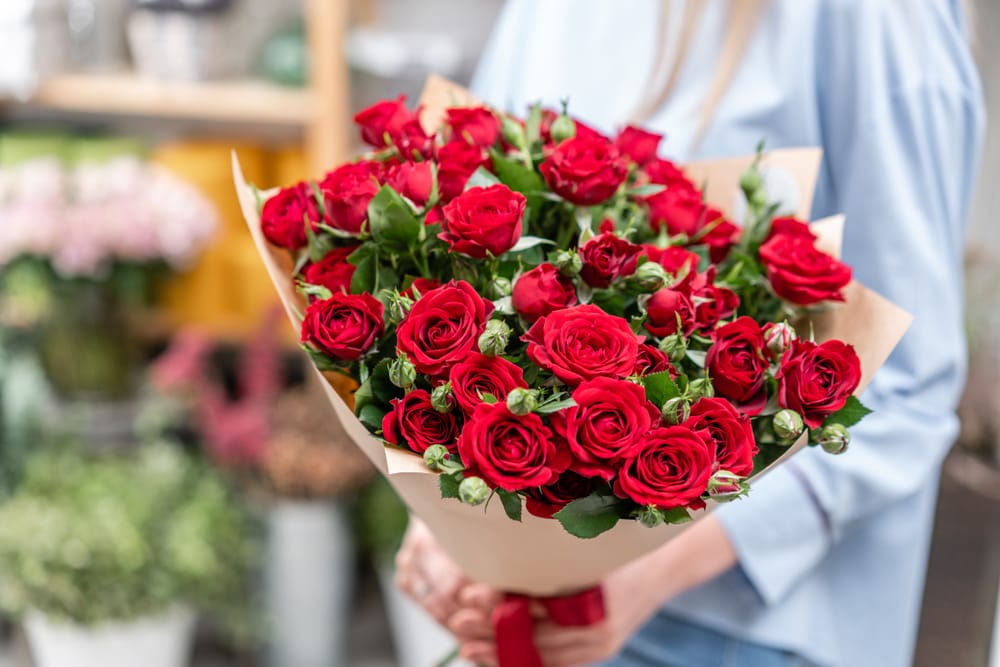
Image Source: Shutterstock.com
When the cold winds start blowing and frost nips at the garden, fresh blooms feel like a distant memory. But who says your winter home has to be devoid of floral cheer? Drying flowers is like hitting the pause button on summer and fall, preserving color, shape, and beauty long after the growing season ends.
The best part is that dried flowers don’t just survive—they thrive, turning into charming, rustic, and long-lasting decorations. If you’ve ever wanted your living space to smell like a cozy garden even in the middle of January, it’s time to dive into the world of flower drying.
1. Roses: Timeless Beauty Preserved
Roses aren’t just romantic; they’re surprisingly resilient when dried properly. Their petals can hold rich colors for months if you hang them upside down in a dark, dry, and well-ventilated spot. Try drying multiple varieties at once—you’ll notice subtle differences in color and shape that make every bouquet unique. Even the tiniest buds can create an elegant touch when arranged in jars or wreaths. Drying roses is simple, but the payoff is a winter bouquet that looks like it came straight from a secret garden tucked into your living room.
2. Lavender: Fragrant And Functional
Lavender is famous for its calming aroma, and the magic only intensifies as it dries. Tie the stems into small bundles and hang them upside down to preserve both scent and color. The soft purple hues darken slightly, giving your arrangements a more rustic, cozy vibe. Dried lavender isn’t just decorative; it can freshen drawers, closets, or even a bath when used creatively. By the time the snow falls, a bundle of lavender can make your home feel like a warm, fragrant retreat.
3. Hydrangeas: Big Blooms, Big Impact
Hydrangeas are perfect for adding drama to a winter bouquet. Their large, round blooms look even more striking when dried, with subtle shifts in color that highlight every petal. You can preserve them by air drying or using a silica gel method to maintain their delicate shape. Once dried, they pair beautifully with smaller blooms or dried grasses for a layered, textured look. Hydrangeas turn ordinary arrangements into eye-catching statements, keeping your home colorful even during the grayest months.
4. Statice: Small Flowers With Endless Charm
Statice is a favorite among dried flower enthusiasts for a reason—it keeps its vibrant colors long after drying. Purple, pink, yellow, and white stems all dry beautifully without much fuss. The tiny blooms add a whimsical, airy texture to bouquets, making them appear fuller and more dynamic. Statice pairs well with almost any dried flower, from roses to eucalyptus, and lasts for months without losing its charm. It’s the perfect pick-me-up for winter arrangements that need a pop of playful color.
5. Strawflowers: Paperlike Petals That Last
Strawflowers are aptly named—their petals feel almost like stiff paper, which is exactly why they dry so well. These blooms retain color brilliantly, from bold reds and oranges to soft pastels, making them perfect for winter decor. Simply hang them upside down or place them on a drying rack, and watch them transform into miniature floral sculptures. Their texture gives bouquets a unique, tactile quality that fresh flowers can’t offer. Dried strawflowers are ideal for anyone who wants a long-lasting, vibrant winter arrangement that feels both whimsical and elegant.

Image Source: Shutterstock.com
6. Celosia: Bold And Unexpected
Celosia is all about drama, with flame-like plumes that make any bouquet pop. When dried, the colors often deepen and intensify, creating a fiery focal point for your winter arrangements. These flowers are surprisingly sturdy and hold their shape, so they can be used in tall vases or mixed with softer, more delicate blooms. Their unusual texture adds depth and intrigue, making a bouquet look curated and sophisticated. Celosia is perfect for floral enthusiasts who like a little flair and a lot of character in their arrangements.
7. Baby’s Breath: Delicate And Airy
Baby’s breath is the unsung hero of dried bouquets. Its tiny, cloudlike clusters add a sense of lightness and elegance to any arrangement, balancing out larger or more vivid flowers. Air drying works best, and the stems can be dyed if you want to experiment with colors that complement your home decor. Even months after drying, baby’s breath keeps its shape and charm, adding subtle beauty without overwhelming other blooms. It’s an essential filler that transforms a simple bouquet into a dreamy winter centerpiece.
8. Eucalyptus: Greenery That Stands The Test Of Time
While flowers often take the spotlight, dried greenery like eucalyptus gives your arrangements depth and structure. Eucalyptus leaves dry naturally and maintain a soft, muted green, perfect for neutral or seasonal color schemes. Their long stems make them ideal for draping in tall vases or weaving into wreaths and garlands.
Beyond beauty, eucalyptus adds a fresh scent that subtly infuses the room, making it feel vibrant and alive even in the middle of winter. Pairing eucalyptus with dried flowers completes the look, creating a balanced, professional-quality bouquet.
Preserve Nature’s Beauty All Year
Drying flowers is more than just a craft—it’s a way to hold onto the fleeting beauty of each season and bring it into the heart of winter. From roses to eucalyptus, these blooms allow you to build arrangements that are lasting, vibrant, and full of personality. The best part is the satisfaction of seeing your flowers transform and knowing they’ll bring joy long after they would have faded in the garden.
Have you tried drying flowers for winter bouquets? Share your stories, favorite flowers, or creative tips in the comments section below.
You May Also Like…
How Autumn Pollinators Choose Their Flowers
7 Flowers That Self-Seed and Return Next Spring
Why Winter Cover Crops Boost Soil Health
The Cover Crop That Revives Dead Soil Over Winter
7 Flowers That Only Show Their Best Color in Fall
Leave a Reply